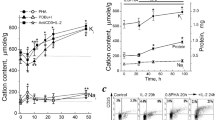Summary
Trace metals are essential for the growth and several other properties of human lymphocytes. We studied the effects of media with variable concentrations of three metals (Fe2+, Cu2+, Zn2+), a metal chelator (deferoxamine, DFX) and a cell-growth inhibitor (hydroxy-urea) on the growth, intracellular metal concentration and activity of the enzyme ribonucleotide reductase in murine leukemic lymphocytes (L1210). Intracellular concentrations of Fe and Cu fluctuated within narrow limits in normal media, but decreased to very low concentrations in metal-poor media. The intracellular Zn concentration did not vary appreciably. Growth in intact cells decreased by 50%–70% when normal media were replaced by metal-poor media, but returned to control values when media were supplemented with gradually increasing concentrations of Fe and Cu. Fe and Cu had synergistic effects, while Zn had no stimulatory action. Hydroxyurea and DFX both inhibited cell growth, but only DFX inhibition was reversed by addition of metals. The addition of the above metals and inhibitors to the cell extracts produced effects on ribonucleotide reductase activity similar to those observed on the growth of whole cell preparations (stimulation by Fe and Cu, inhibition by Zn, DFX and hydroxyurea). These findings show that (a) the intracellular metal concentration is maintained in a narrow range during cell growth; (b) ribonucleotide reductase activity varies with cell growth; (c) ribonucleotide reductase activity and cell growth increase with Fe and Cu and decrease with Zn and DFX. Our data suggest that (a) Fe, Cu and Zn may have some effect on the growth and ribonucleotide reductase activity of L1210 cells, that (b) Fe, Cu and Zn may operate in a related and interdependent way and that (c) DFX inhibits cell growth probably through inhibition of the reductase activity and chelation of the Fe of its Fe-containing subunit. We conclude that any study on one of these metals should always include the other two and that manipulation of intracellular metals should be investigated as a potential therapeutic modulator of growth in leukemic lymphocytes.
Similar content being viewed by others
Abbreviations
- DFX:
-
deferoxamine
References
Agget PJ, Crofton RW, Khin C, Gvozdanovic S, Gvozdanovic D (1983) The mutual inhibitory effects on their bioavailability of inorganic zinc and iron. In: Prasad AS, Cadvar AO, Brewer GJ, Agget PJ (eds) Zinc deficiency in human subjects. Liss, New York, p 117
Backes G, Sahlin M, Sjoberg BM, Loehr TM, Sanders-Loehr J (1989) Resonance Raman spectroscopy of ribonucleotide reductase. Evidence for deprotonated tyrosil radical and photochemistry of the binuclear iron center. Biochemistry 28:1923
Bergeron RJ (1986) Iron: a controlling nutrient in proliferative process. Trends Biochem Sci 11:133
Borovansk'y J, Riley PA (1989) Cytotoxicity of zinc in vitro. Chem Biol Interact 69:279
Bradford MM (1976) A rapid and sensitive method for the quantitation of microgram quantities of protein, utilizing the principle of protein dye binding. Anal Biochem 72:248
Carpentieri U, Thorpe LW (1987) In vitro leukemic cell differentiation in metal-depleted media. Anticancer Res 7:143
Carpentieri U, Myers J, Thorpe L, Daeschner CW III, Haggard ME (1986) Copper, zinc and iron in normal and leukemic lymphocytes from children. Cancer Res 46:981
Carpentieri U, Kalmaz G, Ezell E, Thorpe L (1988) Trace metals, surface receptors and growth of human normal and leukemic lymphocytes. Anticancer Res 8:1393
Carpentieri U, Myers J, Daeschner CW III, Haggard ME (1987) Observations on the use of a cation exchange resin for the preparation of metal-depleted media for lymphocyte culture. J Biochem Biophys Methods 14:93
Cory JG (1988) Ribonucleotide reductase as a chemotherapeutic target. Adv Enzyme Regul 27:437
Cory JG, Carter GL (1988) Leukemic L1210 cells lines resistant to ribonucleotide reductase inhibitors. Cancer Res 48:839
Csermely P, Szamel M, Resch K, Somogyi J (1988) Zinc can increase the activity of protein kinase C and contribute to its binding to plasma membrane in T lymphocytes. J Biol Chem 263:6487
Dezza L, Cazzola M, Danova M, Carlo-Stella C, Bergamaschi G, Brugnatelli S, Invernizzi R, Mazzini G, Riccardi A, Ascari E (1989) Effects of desferoxamine on normal and leukemic human hematopoietic cell growth: in vitro and in vivo studies. Leukemia 3:104
Estrov Z, Tawa A, Wang X-H, Dube IA, Sulh H, Cohen A, Gelfand EW, Freedman MH (1987) In vitro and in vivo effects of deferoxamine in neonatal acute leukemia. Blood 69:757
Farr RA, Bey P, Sunkara PS, Lippert BJ (1989) Synthesis of acyclonucleoside hydroxamine acids as inhibitors of ribonucleotide reductase. J Med Chem 32:1879
Harris ED (1983) Copper in human and animal health. In: Rose J (ed) Trace elements in health. Butterworth, London, p 44
Huebers HA, Finch CA (1987) The physiology of transferrin receptors. Physiol Rev 67:520
Kaplinsky C, Estrov Z, Freedman MH, Gelfand EW, Cohen A (1987) Effect of deferoxamine on DNA synthesis, DNA repair, cell proliferation and differentiation of HL-60 cells. Leukemia 1:437
Oblender M, Carpentieri U (1990) Effects of iron, copper and zinc on the activity of ribonucleotide reductase in normal and leukemic human lymphocytes. Anticancer Res 10:123
Takeda E, Hirose M, Kuroda Y, Ninomiya T, Toshima K, Watanabe T, Ito M, Naito E, Miyao M (1984) Ribonucleotide reductase and thymidine kinase activities in various cultured cell lines derived from hematologic malignancies. GANN 75:816
Veale D, Armichael J, Cantwell BM, Elford HL, Blackie R, Kerr DJ, Kaye SB, Harris AL (1988) A phase 1 and pharmacokinetic study of didox: A ribonucleotides reductase inhibitor, Br J Cancer 58:70
Westin G, Schaffner W (1988) Heavy metal ions in transcription factors from Hela cell: Sp 1, but not octamer transcription factor requires zinc for DNA binding and for activator function. Nucleic Acid Res 16:5771
Whitehouse RC, Prasad AS, Rabbani PI, Cossack ZT (1982) Zinc in plasma, neutrophils, lymphocytes and erythrocytes as determined by flameless atomic absorption spectrophotometry. Clin Chem 28:475
Author information
Authors and Affiliations
Rights and permissions
About this article
Cite this article
Oblender, M., Carpentieri, U. Growth, ribonucleotide reductase and metals in murine leukemic lymphocytes. J Cancer Res Clin Oncol 117, 444–448 (1991). https://doi.org/10.1007/BF01612765
Received:
Accepted:
Issue Date:
DOI: https://doi.org/10.1007/BF01612765




